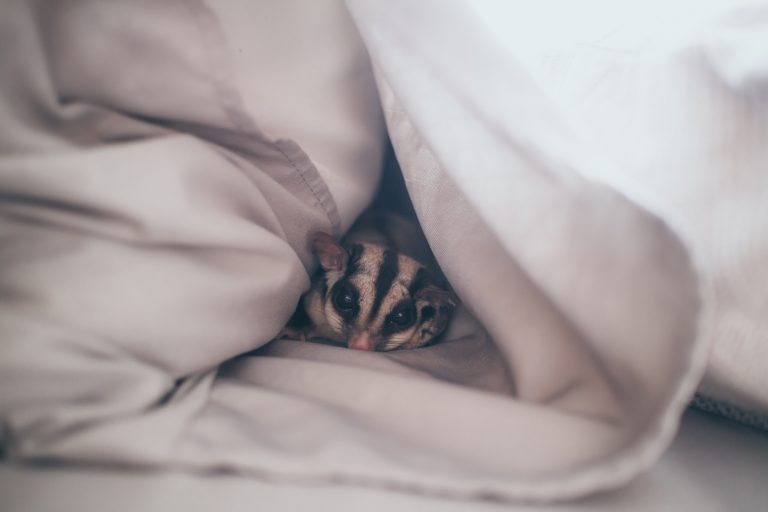Can Sugar Gliders Eat Chocolate? (Sugar Glider Diet FAQ)
Chocolate is a very popular treat for humans but is very sweet and high in sugar. Sugar gliders are omnivorous and can eat both plant and animal matter. However, some food can’t be fed to sugar gliders and is even toxic to them. So, can sugar gliders eat chocolate safely or is it toxic?
Sugar gliders can’t eat chocolate. Chocolate contains theobromine, a chemical compound, which is toxic to sugar gliders. All chocolate is also high in sugar and fat, which is bad for your glider’s health. As such chocolate is absolutely unsuitable as food or treats for your sugar gliders.
You might think that a small amount of chocolate won’t hurt your sugar glider, but this isn’t exactly true. There are cases of toxicity at low levels of theobromine in other (much larger) pets. Besides that, why would you give something that isn’t nutritional to your sugar gliders?
Some resources will say that some chocolate doesn’t contain any theobromine and isn’t toxic. Theobromine is a compound that gives the typical brown color to brown and dark chocolate. But even white chocolate contains trace amounts of theobromine.
Milk and dark chocolate also contains (high) levels of caffeine and contain lactose. Since sugar gliders are lactose intolerant and can’t handle high caffeine levels, it’s recommended to stay away from chocolate in any form.
In this article, you’ll learn more about the dangers of feeding chocolate to your sugar gliders. You’ll learn what non-toxic and healthy treats can be fed to your sugar gliders without a problem.
This site contains affiliate links to products we recommend and use ourselves. We may receive a commission for purchases that you make through these links. If you’re interested in learning more about our affiliate links, please visit our (affiliate) disclaimer.
Nutritional Value of Chocolate
The nutritional value of chocolate is low for sugar gliders but this doesn’t mean that chocolate doen’t have any nutrients in them. The following nutritional data (for 100 g) comes from FoodData Central:
| Name | Amount | Unit |
|---|---|---|
| Energy | 550 | kcal |
| Protein | 12.5 | g |
| Total lipid (fat) | 37.5 | g |
| Carbohydrate, by difference | 47.5 | g |
| Fiber, total dietary | 2.5 | g |
| Sugars, total including NLEA | 40 | g |
| Calcium, Ca | 100 | mg |
| Iron, Fe | 1.8 | mg |
| Sodium, Na | 75 | mg |
| Vitamin C, total ascorbic acid | 0 | mg |
| Fatty acids, total saturated | 12.5 | g |
| Fatty acids, total trans | 0 | g |
| Cholesterol | 12 | mg |
Why Is Chocolate Bad For Sugar Gliders?
As you can see in the table above chocolate is high in carbohydrates and fat. It also contains a lot of sugar and is a high-calorie food. When fed to sugar gliders the high sugar and fat content can lead to obesity and diabetes, if it weren’t for the toxic compound theobromine.
A normal sugar glider diet needs to consist of around 20 percent protein and 8 percent fat. Chocolate obviously doesn’t provide these levels of protein and fat. I won’t go any further into the nutritional value of chocolate but will give you more information about troublesome compounds in chocolate (from a sugar glider perspective):
- theobromine
- caffeine
- milk
As you’ll see there are some compounds in chocolate that can be toxic in small amounts or can at least cause health issues. For this reason, I strongly advise you to NEVER give chocolate (white, milk, dark, or any food that contains chocolate) to your sugar gliders and to keep them away from chocolate products so they can’t ingest them by accident.
Theobromine
What is theobromine?
Theobromine is a chemical compound that’s present in cacao (and so also in chocolate). It can also be found in other foods, like the leaves of the tea plant. But chocolate has by far the highest levels of theobromine in it. The following estimated levels of theobromine are available in different chocolate and cacao products:
- cacao powder: 2634 mg per 100 g
- unsweetened baking chocolate: 1297 mg per 100 g
- dark chocolate: 500 to 800 mg per 100 g
- milk chocolate: 214 mg per 100 g
White chocolate contains only trace amounts of theobromine (around 0.1 mg/g according to this research).
Why is theobromine bad for (small) pets?
Humans can consume fairly large amounts of theobromine (250mg). The reason for this is that humans can break down theobromine very efficiently compared to other animals. However, high amounts of theobromine (more than 1000mg) can also lead to headaches and nervousness in humans.
Theobromine is mostly a problem for dogs and small pets. A normal amount of chocolate for humans can cause serious health issues, and even death, for dogs and cats. Small pets are mostly in danger because of their low weight.
LD50 of theobromine
Scientists use the LD50 measurement to determine how deadly a substance is. It’s the median lethal dose which means that that dose kills half of the tested population. Such studies are mostly done on mice and rats but are also known for dogs and cats because these animals usually (accidentally) ingest theobromine (from chocolate products).
There is currently no published research that has determined the LD50 of theobromine for sugar gliders. Since there are no studies of the LD50 of theobromine in sugar gliders we can only compare with other animals that were subject to studies.
| Animal | LD50 Theobromine (source) |
|---|---|
| Rat | 1265 mg/kg |
| Mouse | 837 mg/kg |
| Dog | 250–500 mg/kg |
| Cat | 200 mg/kg |
The LD50 of theobromine in rats and mice is fairly high, even comparable to that of humans. However, sugar gliders are small animals and can easily get too much theobromine from a small piece of chocolate.
Let’s hypothesize that the LD50 of theobromine for sugar gliders is 1000 mg/kg. An adult sugar glider can weigh up to 130 grams. This means that ingesting 130 mg of theobromine can cause serious health issues and even death.
An dose of 130 mg theobromine can be compared to eating:
- 15 g of dark chocolate
- 60 g of milk chocolate
So, even a small piece of chocolate can kill 50 percent of sugar gliders. It’s possible that the LD50 is comparable to that of dogs and cats. This would lead to the smallest amounts of chocolate being toxic.
Younger sugar gliders weigh much less and would reach the hypothesized LD50 with a small piece of milk or dark chocolate.
Caffeine
How much caffeine is in chocolate?
Besides theobromine, there’s also caffeine in milk and dark chocolate. White chocolate doesn’t contain caffeine just as it only contains small trace amounts theobromine.
Dark chocolate not only has the highest theobromine content but also the highest caffeine content. Dark chocolate has up to 70 mg of caffeine per 100 g. Milk chocolate contains around 40 mg of caffeine per 100 g.
Why is caffeine bad for (small) pets?
Caffeine is, just like theobromine, a methylxanthine. Both are the main toxic compounds in chocolate. In combination, they form a danger for your sugar gliders.
LD50 of caffeine
For dogs, the LD50 of caffeine has been determined to be 140 mg/kg (source). Humans have a little higher LD50 that ranges between 150 and 200 mg/kg. A study also has determined the LD50 of caffeine in albino rats. This study established an LD50 of 367 mg/kg.
For sugar gliders, this LD50 hasn’t been determined. If sugar gliders would have a LD50 of caffeine similar to that of dogs, only small amounts of chocolate could be tolerated. Let’s take the previously mentioned weight of 130 g for an average adult sugar glider. In such a case, the sugar glider would ingest the median lethal dose at 18 mg of caffeine (45 g of milk chocolate or 26 g of the dark chocolate).
Milk
Animals usually lose the enzymes that are required to digest milk after weaning. Most adult animals don’t consume milk and are lactose intolerant, which means they can’t properly digest milk (products).
Not all chocolate contains lactose. Below you can find the lactose content of chocolate:
- dark chocolate (75% cacao): 0 to 0,5 g per 100 g
- milk chocolate: 9,5 g per 100 g
Chocolate Toxicity
There are no studies online that researched the lethal dose of theobromine and caffeine in sugar gliders. It’s difficult to determine the health issues that sugar gliders can get when ingesting chocolate but similarities can be expected with the signs of theobromine toxicity in other (small) pets.
Symptoms of chocolate toxicity (depending on dose)
- hyperactivity
- drooling
- diarrhea
- high heart rate
- high blood pressure
- irregular heartbeat
- tremors
- seizures
If the level of theobromine (and caffeine) is high enough or if there are complications from the other health issues it can cause, death can follow. So don’t feed chocolate to your sugar glider!
What To Do When Your Sugar Glider Ate Chocolate?
When your sugar glider has eaten chocolate it’s important to seek the help and advice of a vet. Since I’m no vet I can’t give any further advice.
The treatment (for dogs) usually consists of treating the symptoms with medication and stabilizing the pet. It’s also key to get the theobromine and caffeine out of their system as soon as possible. With dogs, this is partially done by letting the dog vomit.
If you haven’t already done so, find a vet in your neighborhood that’s specialized in sugar gliders and write down their number. Put it down on a piece of paper and keep it close for emergencies. Also, locate the nearest pet hospital and do the same.
If you live in the USA you can find emergency vets and pet hospitals on vetlocator.com and emergencyvetsusa.com.
What Treats Are Safe for Sugar Gliders?
So, sugar gliders shouldn’t be fed chocolate but what can they eat? There are a lot of safe and healthy treats available for sugar gliders:
- yogurt drops
- dried fruit
- insects
If you want to give ready-to-go snacks to your sugar gliders I would recommend the following snacks:
Want to Learn More?
If you want to learn more about sugar gliders or other pocket pets, please read the following articles:


